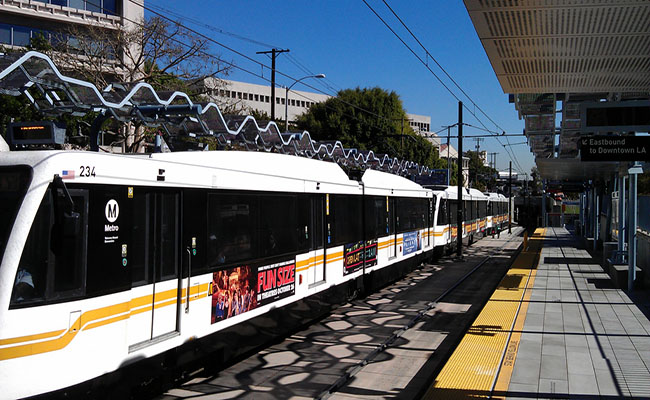Raymond Castro, a 44-year-old unemployed worker, is woefully familiar with Los Angeles’ infamous traffic snarls. Castro has been working construction for more than 30 years and has spent a considerable amount of time — sometimes more than two hours — commuting to various work sites. Now, a hiring provision recently implemented by Metro could make it possible for Castro to stay in his South Los Angeles neighborhood for work.
Castro said he hopes the Project Labor Agreement “opens up opportunities for myself and others” living in the community.
The 8.5-mile Crenshaw/LAX light rail line, approved for construction in 2012, promised to connect the Crenshaw Corridor to other parts of the city, such as the South Bay and the Los Angeles International Airport. And in 2011 when Metro passed the Project Labor Agreement, a measure aimed to designate a percentage of the construction jobs to local residents, residents presumed the line construction meant an opportunity for employment.
“The construction for the line could be an example of renewal,” said Lola Smallwood Cuevas, director of the Los Angeles Black Work Center, an organization dedicated to reducing employment discrimination. “It could create new jobs, provide transportation and bring investments to the community. It could be a triple bottom line victory for our community.”
The PLA states that 40 percent of the construction jobs must go to people living in zip codes with high unemployment rates, according to Metro. Of that 40 percent, 10 percent of jobs must be assigned to disadvantaged workers, such as veterans or emancipated foster care youth. The agreement also stipulates that 20 percent of workers should be apprentices who have spent more than 4,000 hours learning a particular trade.
Because the project receives federal funding, all people living in zip codes with high unemployment rates are eligible to work on the line. The unions cannot pick workers from specific zip codes , but are expected to select employees from neighborhoods within Los Angeles County because of its proximity and areas with high unemployment rates.
The Crenshaw/LAX line, which broke ground on Jan. 21, is Metro’s first project that will be started and completed with the labor agreement in place.
Before the PLA, there were no specific rules in Los Angeles instructing unions to hire local residents for construction projects taking place in their neighborhoods. Many construction workers said they found that problematic.
“For construction work people always get hand-picked,” said Castro, who is eager to land a job on the Crenshaw/LAX line. “With all these projects rising up here in the neighborhood, we are still unemployed because there is not job fairness.”

South Los Angeles residents walk pass the construction site for the Crenshaw/LAX line on Crenshaw and Exposition Boulevards. A new labor agreement between the union and contractors could lead to more jobs for residents in the coming years. | Jordyn Holman
Metro officials said they expect to hire approximately 350 people during the five-year project.
Despite residents’ concerns, Miguel Cabral, who is in charge of PLA’s business outreach campaign, said Metro is pleased with its hiring progress thus far.
“There are people who said we’re not hiring African Americans, but we are,” Cabral said. “The numbers are high.”
According to a Metro report from late last year, project contractor’s Walsh/Shea Corridor Constructors had hired nearly 60 percent of its workers from economically disadvantaged areas, nearly 20 percent more than mandated by federal funding provisions. Similarly, disadvantaged workers made up 30 percent of Walsh/Shea’s workforce, exceeding the PLA’s requirement of 10 percent.
However, the number of apprentices hired to date remains low.
“This project is so early on and they’re going so well that we’re giving [Walsh/Shea] time to improve,” Cabral said.
In addition, officials said that because all jobs are dispatched from the building and trades union, employers rely greatly on referrals and experience.
“The apprenticeship is always the avenue to enter,” said Anne-Marie Otey, a director at the Los Angeles/Orange Counties Building and Contracting Trades Council. “This is almost always the case, with a few exceptions.”
Erich Engler, a business manager at Walsh/Shea, said construction jobs on the Crenshaw/LAX line could be a launchpad for careers.
“Metro has a lot of upcoming projects that can be part of the PLA,” Engler said. “We want to ensure that residents in the community have the skill sets to work on these projects.
Smallwood Cuevas from the Los Angeles Black Work Center said the skill-sets are already in the community; the PLA simply must tap into what is already present and available.
“People are trained but there’s certainly a need to continue building a pipeline,” she said. “Many more African American men and women should view this as an industry that they can see themselves represented in.”
Many believe the PLA will impact the community even after the final tracks are laid.
“The PLA is really a portal for area residents to learn a trade, work on a project and hopefully make this into a career,” Cabral said.
Many organizers and residents said they would continue working with officials and the union as the job hiring process continues.
“At the end of the day, what we want to see is a collective approach to solving the black job crisis in South Los Angeles,” Smallwood Cuevas said.
















Speak Your Mind